University Law Assignment: Law of Tort and Negligence Case Study
VerifiedAdded on 2022/08/17
|5
|1029
|14
Case Study
AI Summary
This document presents a detailed analysis of a case study involving the law of tort and negligence. The assignment explores the liability of an occupier (Mr. Mackey) when a guest (Stan) is injured due to a defective property. The analysis applies the principles established in landmark cases such as Donoghue v Stevenson, addressing the duty of care, breach of duty, and the resulting injury. The solution also investigates potential defenses available to Mr. Mackey, including contributory negligence and the doctrine of volenti non fit injuria, referencing cases like Romeo v Conservation Commission of the Northern Territory and Froom v Butcher. The analysis incorporates relevant legislation, including the Law of Negligence and Limitation of Liability Act 2008 and the Civil Liability Act 2020, to provide a comprehensive legal perspective on the scenario.
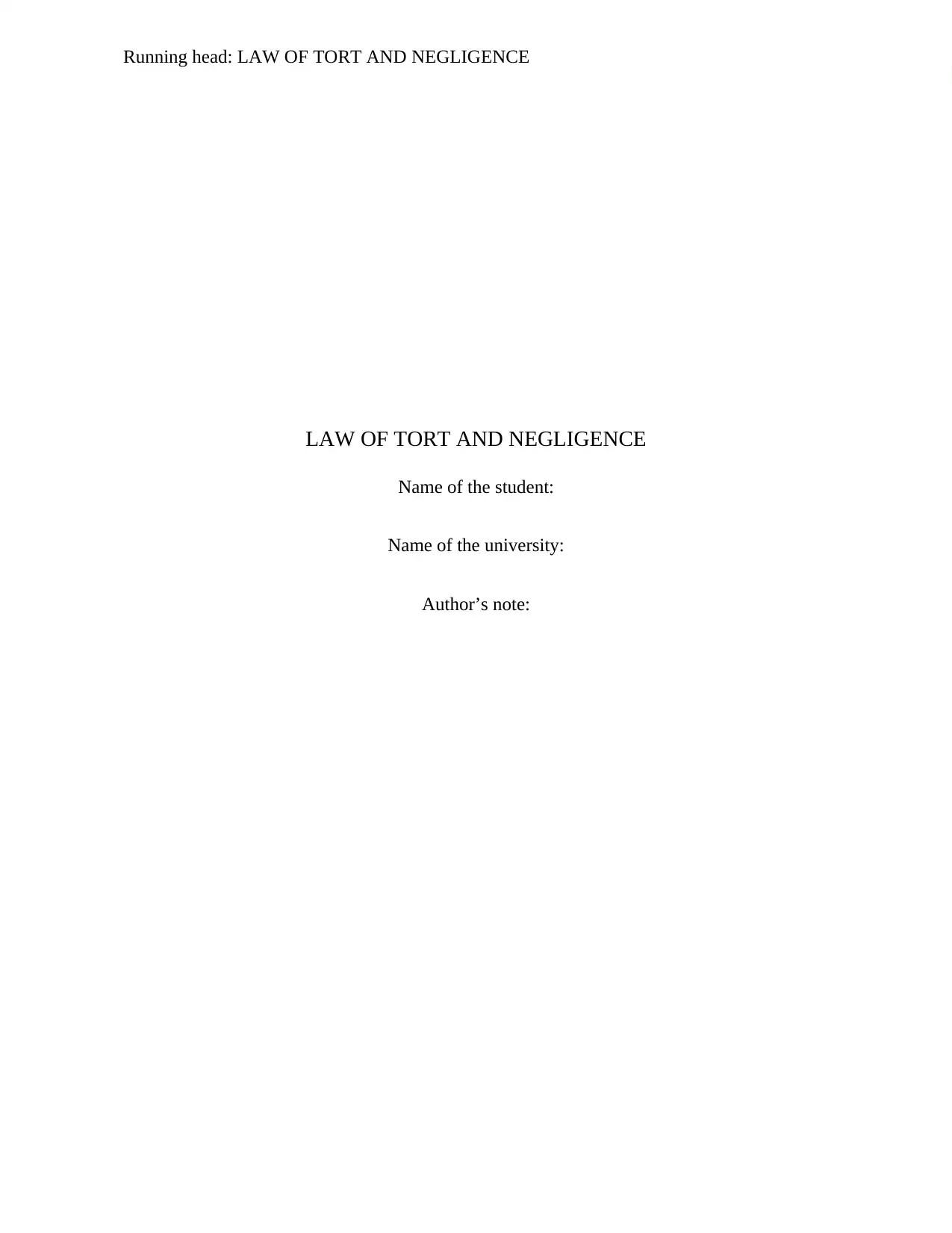
Running head: LAW OF TORT AND NEGLIGENCE
0
LAW OF TORT AND NEGLIGENCE
Name of the student:
Name of the university:
Author’s note:
0
LAW OF TORT AND NEGLIGENCE
Name of the student:
Name of the university:
Author’s note:
Paraphrase This Document
Need a fresh take? Get an instant paraphrase of this document with our AI Paraphraser
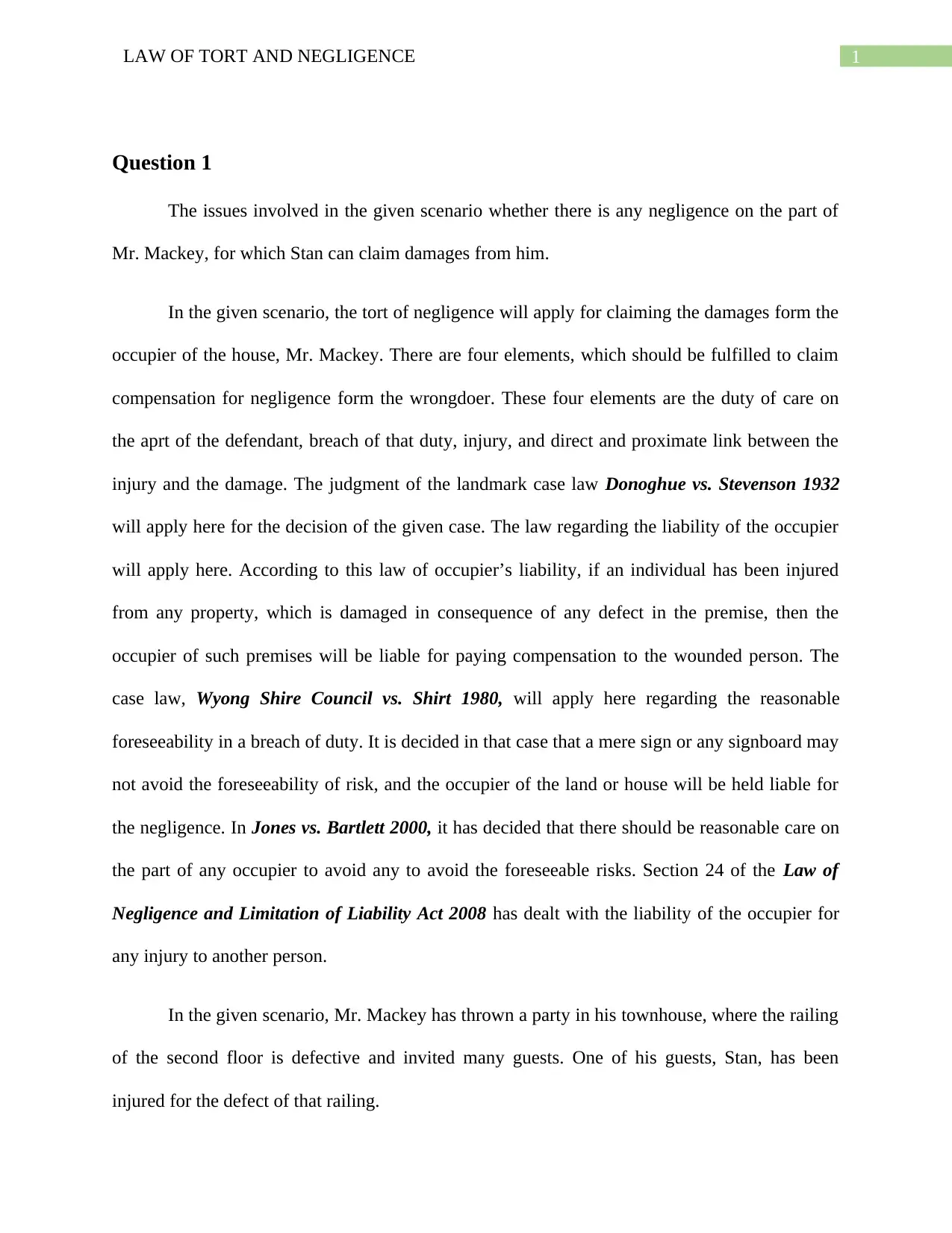
1LAW OF TORT AND NEGLIGENCE
Question 1
The issues involved in the given scenario whether there is any negligence on the part of
Mr. Mackey, for which Stan can claim damages from him.
In the given scenario, the tort of negligence will apply for claiming the damages form the
occupier of the house, Mr. Mackey. There are four elements, which should be fulfilled to claim
compensation for negligence form the wrongdoer. These four elements are the duty of care on
the aprt of the defendant, breach of that duty, injury, and direct and proximate link between the
injury and the damage. The judgment of the landmark case law Donoghue vs. Stevenson 1932
will apply here for the decision of the given case. The law regarding the liability of the occupier
will apply here. According to this law of occupier’s liability, if an individual has been injured
from any property, which is damaged in consequence of any defect in the premise, then the
occupier of such premises will be liable for paying compensation to the wounded person. The
case law, Wyong Shire Council vs. Shirt 1980, will apply here regarding the reasonable
foreseeability in a breach of duty. It is decided in that case that a mere sign or any signboard may
not avoid the foreseeability of risk, and the occupier of the land or house will be held liable for
the negligence. In Jones vs. Bartlett 2000, it has decided that there should be reasonable care on
the part of any occupier to avoid any to avoid the foreseeable risks. Section 24 of the Law of
Negligence and Limitation of Liability Act 2008 has dealt with the liability of the occupier for
any injury to another person.
In the given scenario, Mr. Mackey has thrown a party in his townhouse, where the railing
of the second floor is defective and invited many guests. One of his guests, Stan, has been
injured for the defect of that railing.
Question 1
The issues involved in the given scenario whether there is any negligence on the part of
Mr. Mackey, for which Stan can claim damages from him.
In the given scenario, the tort of negligence will apply for claiming the damages form the
occupier of the house, Mr. Mackey. There are four elements, which should be fulfilled to claim
compensation for negligence form the wrongdoer. These four elements are the duty of care on
the aprt of the defendant, breach of that duty, injury, and direct and proximate link between the
injury and the damage. The judgment of the landmark case law Donoghue vs. Stevenson 1932
will apply here for the decision of the given case. The law regarding the liability of the occupier
will apply here. According to this law of occupier’s liability, if an individual has been injured
from any property, which is damaged in consequence of any defect in the premise, then the
occupier of such premises will be liable for paying compensation to the wounded person. The
case law, Wyong Shire Council vs. Shirt 1980, will apply here regarding the reasonable
foreseeability in a breach of duty. It is decided in that case that a mere sign or any signboard may
not avoid the foreseeability of risk, and the occupier of the land or house will be held liable for
the negligence. In Jones vs. Bartlett 2000, it has decided that there should be reasonable care on
the part of any occupier to avoid any to avoid the foreseeable risks. Section 24 of the Law of
Negligence and Limitation of Liability Act 2008 has dealt with the liability of the occupier for
any injury to another person.
In the given scenario, Mr. Mackey has thrown a party in his townhouse, where the railing
of the second floor is defective and invited many guests. One of his guests, Stan, has been
injured for the defect of that railing.
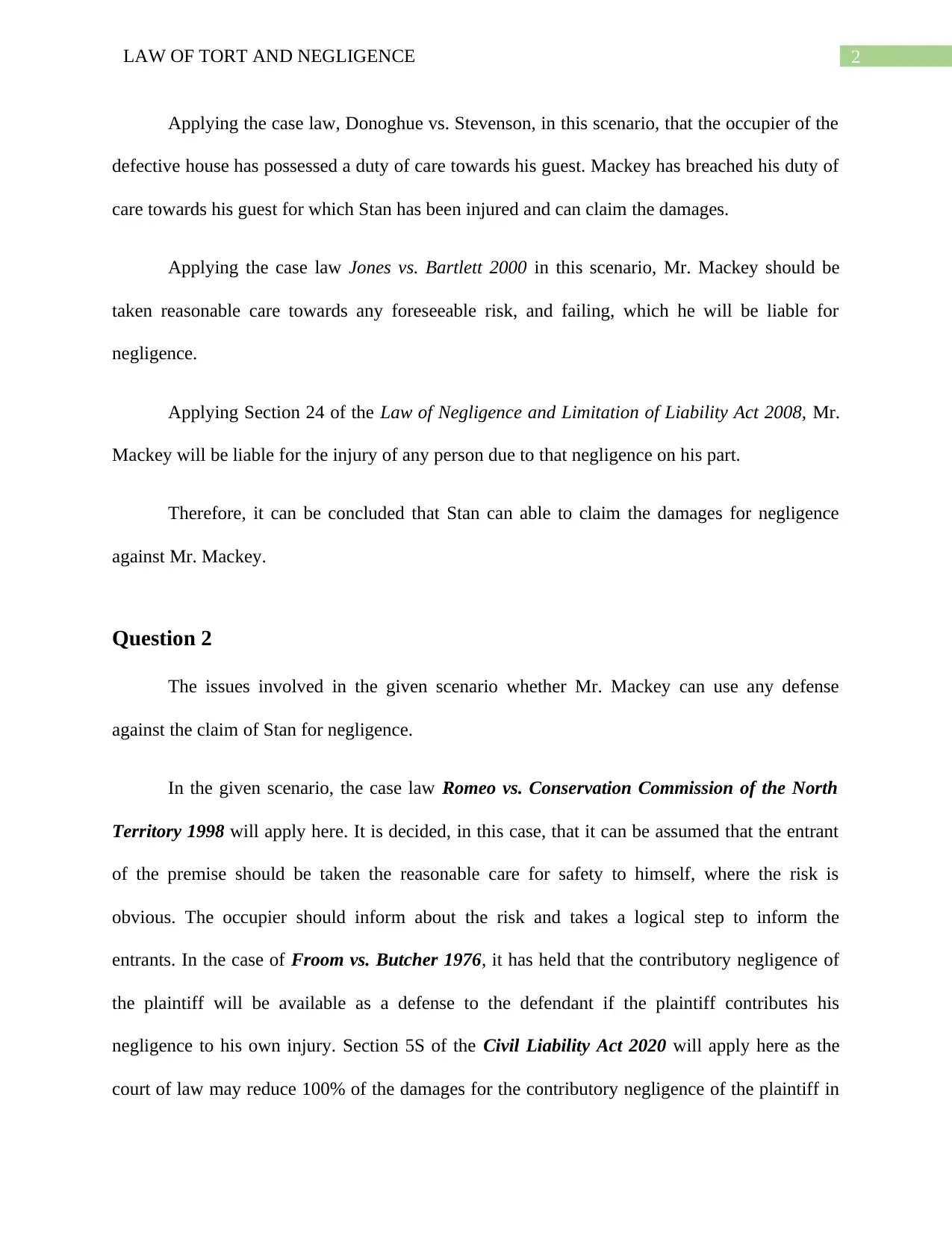
2LAW OF TORT AND NEGLIGENCE
Applying the case law, Donoghue vs. Stevenson, in this scenario, that the occupier of the
defective house has possessed a duty of care towards his guest. Mackey has breached his duty of
care towards his guest for which Stan has been injured and can claim the damages.
Applying the case law Jones vs. Bartlett 2000 in this scenario, Mr. Mackey should be
taken reasonable care towards any foreseeable risk, and failing, which he will be liable for
negligence.
Applying Section 24 of the Law of Negligence and Limitation of Liability Act 2008, Mr.
Mackey will be liable for the injury of any person due to that negligence on his part.
Therefore, it can be concluded that Stan can able to claim the damages for negligence
against Mr. Mackey.
Question 2
The issues involved in the given scenario whether Mr. Mackey can use any defense
against the claim of Stan for negligence.
In the given scenario, the case law Romeo vs. Conservation Commission of the North
Territory 1998 will apply here. It is decided, in this case, that it can be assumed that the entrant
of the premise should be taken the reasonable care for safety to himself, where the risk is
obvious. The occupier should inform about the risk and takes a logical step to inform the
entrants. In the case of Froom vs. Butcher 1976, it has held that the contributory negligence of
the plaintiff will be available as a defense to the defendant if the plaintiff contributes his
negligence to his own injury. Section 5S of the Civil Liability Act 2020 will apply here as the
court of law may reduce 100% of the damages for the contributory negligence of the plaintiff in
Applying the case law, Donoghue vs. Stevenson, in this scenario, that the occupier of the
defective house has possessed a duty of care towards his guest. Mackey has breached his duty of
care towards his guest for which Stan has been injured and can claim the damages.
Applying the case law Jones vs. Bartlett 2000 in this scenario, Mr. Mackey should be
taken reasonable care towards any foreseeable risk, and failing, which he will be liable for
negligence.
Applying Section 24 of the Law of Negligence and Limitation of Liability Act 2008, Mr.
Mackey will be liable for the injury of any person due to that negligence on his part.
Therefore, it can be concluded that Stan can able to claim the damages for negligence
against Mr. Mackey.
Question 2
The issues involved in the given scenario whether Mr. Mackey can use any defense
against the claim of Stan for negligence.
In the given scenario, the case law Romeo vs. Conservation Commission of the North
Territory 1998 will apply here. It is decided, in this case, that it can be assumed that the entrant
of the premise should be taken the reasonable care for safety to himself, where the risk is
obvious. The occupier should inform about the risk and takes a logical step to inform the
entrants. In the case of Froom vs. Butcher 1976, it has held that the contributory negligence of
the plaintiff will be available as a defense to the defendant if the plaintiff contributes his
negligence to his own injury. Section 5S of the Civil Liability Act 2020 will apply here as the
court of law may reduce 100% of the damages for the contributory negligence of the plaintiff in
⊘ This is a preview!⊘
Do you want full access?
Subscribe today to unlock all pages.

Trusted by 1+ million students worldwide
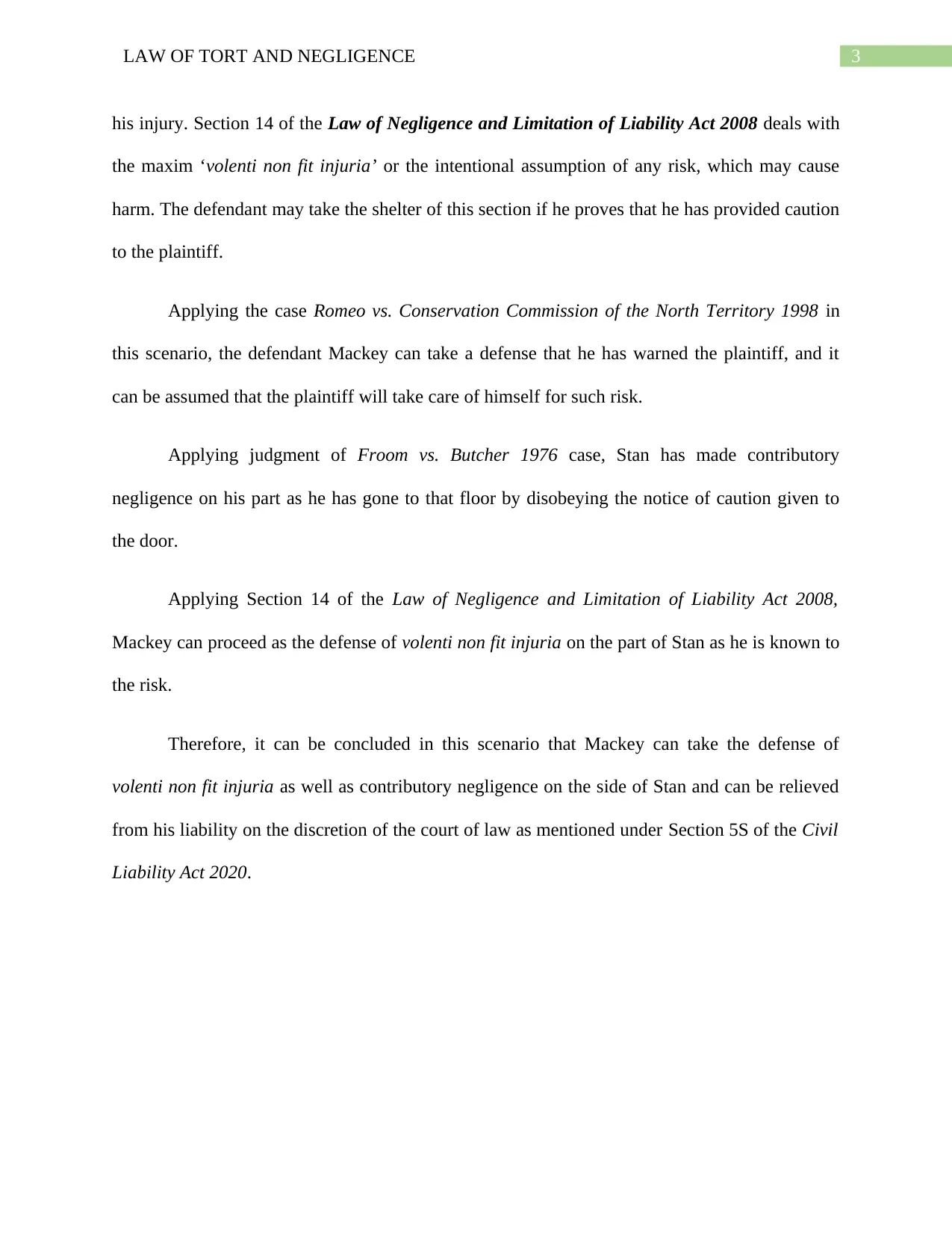
3LAW OF TORT AND NEGLIGENCE
his injury. Section 14 of the Law of Negligence and Limitation of Liability Act 2008 deals with
the maxim ‘volenti non fit injuria’ or the intentional assumption of any risk, which may cause
harm. The defendant may take the shelter of this section if he proves that he has provided caution
to the plaintiff.
Applying the case Romeo vs. Conservation Commission of the North Territory 1998 in
this scenario, the defendant Mackey can take a defense that he has warned the plaintiff, and it
can be assumed that the plaintiff will take care of himself for such risk.
Applying judgment of Froom vs. Butcher 1976 case, Stan has made contributory
negligence on his part as he has gone to that floor by disobeying the notice of caution given to
the door.
Applying Section 14 of the Law of Negligence and Limitation of Liability Act 2008,
Mackey can proceed as the defense of volenti non fit injuria on the part of Stan as he is known to
the risk.
Therefore, it can be concluded in this scenario that Mackey can take the defense of
volenti non fit injuria as well as contributory negligence on the side of Stan and can be relieved
from his liability on the discretion of the court of law as mentioned under Section 5S of the Civil
Liability Act 2020.
his injury. Section 14 of the Law of Negligence and Limitation of Liability Act 2008 deals with
the maxim ‘volenti non fit injuria’ or the intentional assumption of any risk, which may cause
harm. The defendant may take the shelter of this section if he proves that he has provided caution
to the plaintiff.
Applying the case Romeo vs. Conservation Commission of the North Territory 1998 in
this scenario, the defendant Mackey can take a defense that he has warned the plaintiff, and it
can be assumed that the plaintiff will take care of himself for such risk.
Applying judgment of Froom vs. Butcher 1976 case, Stan has made contributory
negligence on his part as he has gone to that floor by disobeying the notice of caution given to
the door.
Applying Section 14 of the Law of Negligence and Limitation of Liability Act 2008,
Mackey can proceed as the defense of volenti non fit injuria on the part of Stan as he is known to
the risk.
Therefore, it can be concluded in this scenario that Mackey can take the defense of
volenti non fit injuria as well as contributory negligence on the side of Stan and can be relieved
from his liability on the discretion of the court of law as mentioned under Section 5S of the Civil
Liability Act 2020.
Paraphrase This Document
Need a fresh take? Get an instant paraphrase of this document with our AI Paraphraser
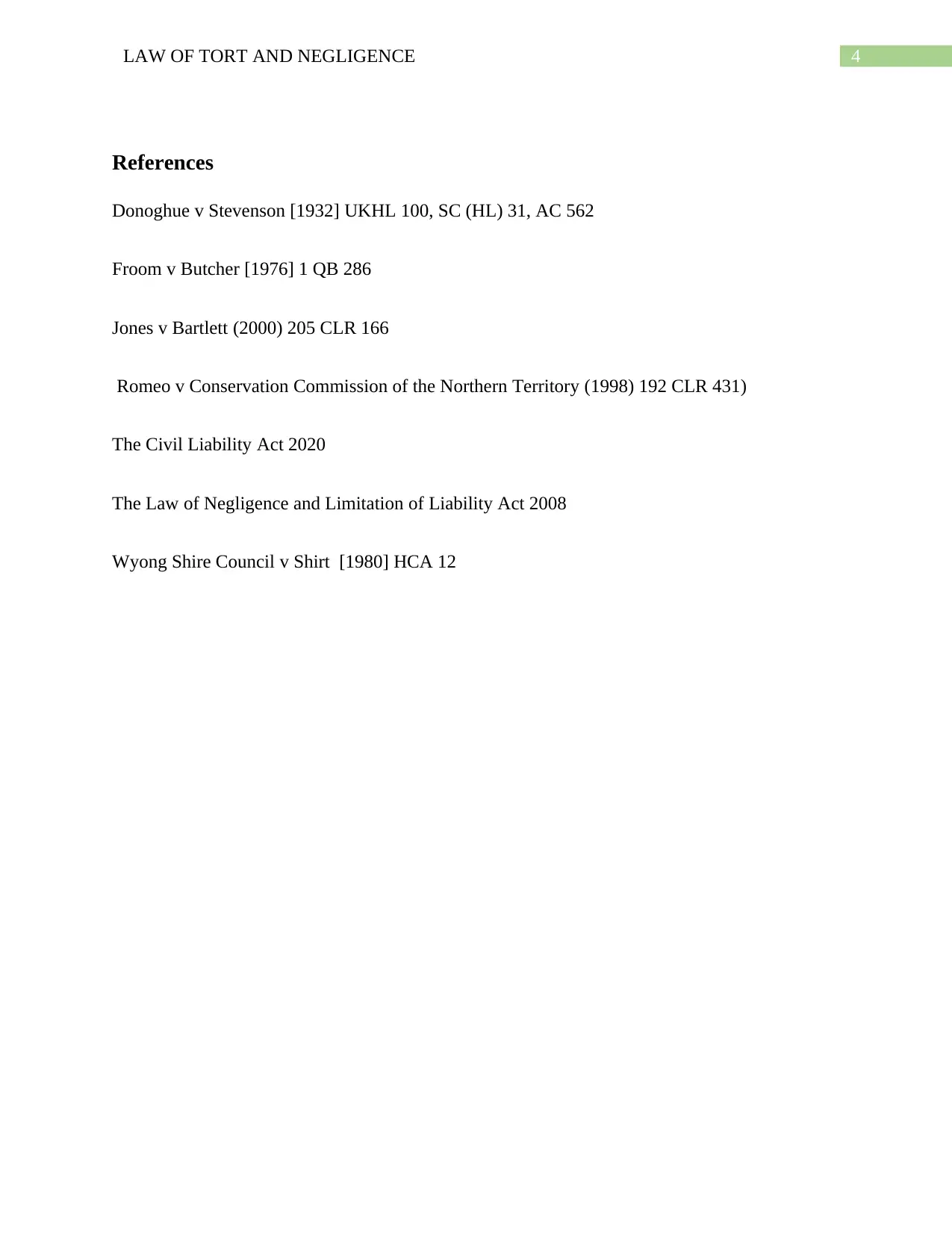
4LAW OF TORT AND NEGLIGENCE
References
Donoghue v Stevenson [1932] UKHL 100, SC (HL) 31, AC 562
Froom v Butcher [1976] 1 QB 286
Jones v Bartlett (2000) 205 CLR 166
Romeo v Conservation Commission of the Northern Territory (1998) 192 CLR 431)
The Civil Liability Act 2020
The Law of Negligence and Limitation of Liability Act 2008
Wyong Shire Council v Shirt [1980] HCA 12
References
Donoghue v Stevenson [1932] UKHL 100, SC (HL) 31, AC 562
Froom v Butcher [1976] 1 QB 286
Jones v Bartlett (2000) 205 CLR 166
Romeo v Conservation Commission of the Northern Territory (1998) 192 CLR 431)
The Civil Liability Act 2020
The Law of Negligence and Limitation of Liability Act 2008
Wyong Shire Council v Shirt [1980] HCA 12
1 out of 5
Related Documents
Your All-in-One AI-Powered Toolkit for Academic Success.
+13062052269
info@desklib.com
Available 24*7 on WhatsApp / Email
![[object Object]](/_next/static/media/star-bottom.7253800d.svg)
Unlock your academic potential
Copyright © 2020–2025 A2Z Services. All Rights Reserved. Developed and managed by ZUCOL.





